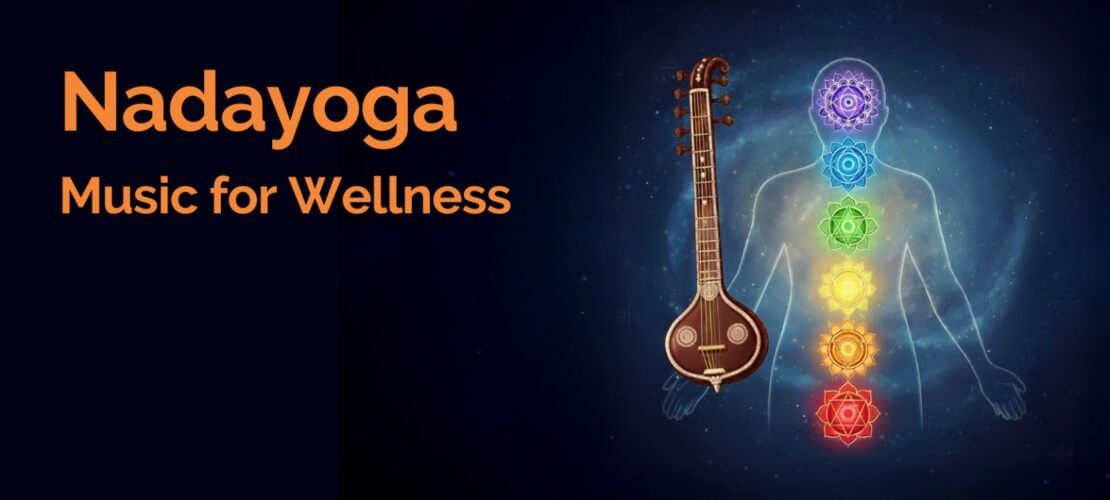
Nadayoga – Music for Wellness
Discover how Nada – the sound influences human energy and emotion. This module explores the resonance of Swaras (musical notes) with the body’s chakras, revealing how each frequency shapes emotional balance and well-being. Through theory and guided listening, participants learn to use Swaras and microtones as tools for inner alignment and therapeutic practice.
Faculty
*The Course may not be offered if the number of registrations is less than 15.
21 January 2026 - 29 April 2026
6:00 PM-7:00 PM IST
Every Wednesday
Introduction
In the study of Music Therapy, Swaras (musical notes) serve as the primary tools for accessing the vibratory fields within the human system. Each Swara carries a specific frequency, which resonates with particular chakras of human body and influences the emotions and physiological functions associated with them. By understanding these vibrational correspondences, one can consciously direct sound to harmonize the subtle energy centers of the body.
While exploring Swara resonance and its connection to the chakras, it becomes essential to take a comprehensive view of the emotional and energetic dynamics that each chakra embodies. Based on their element (Pancha Mahabhoota), every chakra reveals its inherent emotional signatures which functions as an energy vortex regulating not only physiological activity but also the emotional and psychological tendencies. When the natural resonance of these chakras become imbalanced, corresponding emotional disturbances arise, which can be restored through sound-based interventions.
Learning about chakras and emotions through Swara resonance is both a scientific and experiential journey: Scientific in its understanding of vibration, frequency, and resonance and experiential in its capacity to awaken awareness of one’s inner energetic landscape. This integration of sound, emotion, and consciousness constitutes the essence of Raga Chikitsa, the healing through sound vibrations.
Course Objectives
- To explore the foundational principles of how sound, vibration, and Indian Classical Music connect with the body’s energy centers (chakras) for healing and well-being
- To examine the specific vibrational relationship between Swaras (musical notes) and the emotional dynamics that each Chakra holds
- To investigate the practical applications of manipulating note resonance to consciously regulate energy flow and emotional expression within a therapeutic context
Course Outcomes
By the end of this module, participants will be able to:
- Identify and explain the fundamental vibrational correspondences between specific Swaras and the seven primary chakras (Measures Objective 1)
- Recognize and articulate the emotional patterns associated with each chakra and their corresponding musical equivalents in terms of Swara resonance (Measures Objective 2)
- Analyze how subtle microtonal variations (Shrutis) directly influence deeper emotional and energetic responses within the human system (Measures Objective 2, Deeper Understanding)
- Apply foundational Swara-based techniques (Nada Anusandana) to support inner balance, relaxation, and transformation in self-care or emerging therapeutic settings (Measures Objective 3)
Course Syllabus
- Introduction to Music therapy – History/ bheejas versus swaras
- Swaras and Microtones and connection to chakras
- Muladhara Chakra
- Swadishtana Chakra
- Manipura Chakra
- Anahata Chakra
- Vishuddhi Chakra
- Lalana UpaChakra
- Ajna Chakra
- Manam UpaChakra
- Sahasrara Chakra
- Soman UpaChakra
- How energy moves through the chakras
- Nada Anusandana and choice of swaras for different ailments
- Common Maladies and solutions, Q& A and Reflections
Reading List
- The Healing power of Indian Ragas- Rajam Shanker
- Sangita Ratnakara- Sarangadeva
Course Features
- Live Interactive Sessions: Engage in live lectures with opportunities for Q&A
- Flexible Learning: Access recorded sessions and course materials at your convenience
- Certificate of Completion: Earn a certificate upon successfully completing the course
*Important Enrollment Notice: Please note that this course requires a minimum of 15 registrations to commence. If the required number of students is not met, enrolled participants will be notified promptly and provided with options for a full refund or alternative courses.


